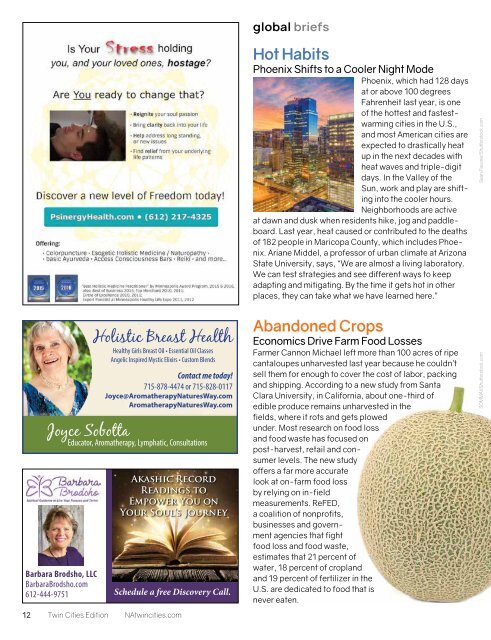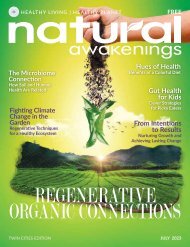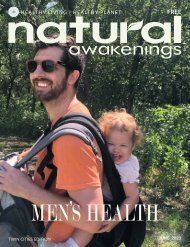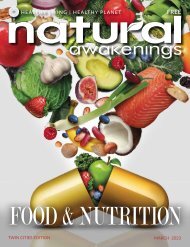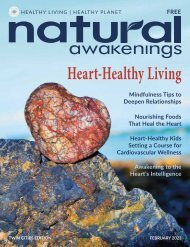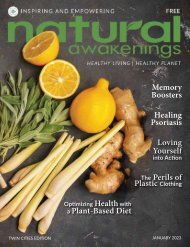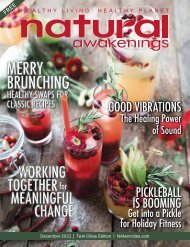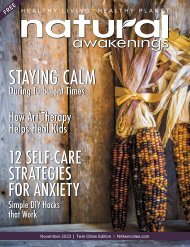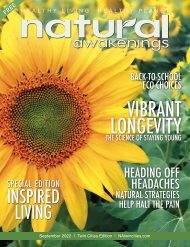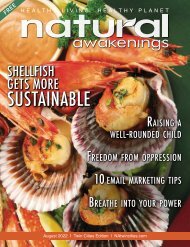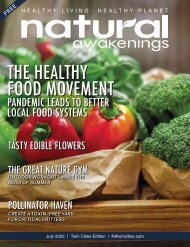Natural Awakenings Twin Cities November 2019
Natural Awakenings Twin Cities magazine is your source for healthy living, healthy planet information. Have you visited our website lately? Sign up for our Newsletter and Digital Magazine, read archived articles from local experts, and keep up with local healthy living events. Visit NATwinCities.com today. We provide a complete toolkit for businesses. List your healthy or green business for free. Enter your calendar events for free.
Natural Awakenings Twin Cities magazine is your source for healthy living, healthy planet information. Have you visited our website lately? Sign up for our Newsletter and Digital Magazine, read archived articles from local experts, and keep up with local healthy living events. Visit NATwinCities.com today.
We provide a complete toolkit for businesses. List your healthy or green business for free. Enter your calendar events for free.
You also want an ePaper? Increase the reach of your titles
YUMPU automatically turns print PDFs into web optimized ePapers that Google loves.
global briefs<br />
Hot Habits<br />
Phoenix Shifts to a Cooler Night Mode<br />
Phoenix, which had 128 days<br />
at or above 100 degrees<br />
Fahrenheit last year, is one<br />
of the hottest and fastestwarming<br />
cities in the U.S.,<br />
and most American cities are<br />
expected to drastically heat<br />
up in the next decades with<br />
heat waves and triple-digit<br />
days. In the Valley of the<br />
Sun, work and play are shifting<br />
into the cooler hours.<br />
Neighborhoods are active<br />
at dawn and dusk when residents hike, jog and paddleboard.<br />
Last year, heat caused or contributed to the deaths<br />
of 182 people in Maricopa County, which includes Phoenix.<br />
Ariane Middel, a professor of urban climate at Arizona<br />
State University, says, “We are almost a living laboratory.<br />
We can test strategies and see different ways to keep<br />
adapting and mitigating. By the time it gets hot in other<br />
places, they can take what we have learned here.”<br />
Sean Pavone/Shutterstock.com<br />
Holistic Breast Health<br />
Healthy Girls Breast Oil • Essential Oil Classes<br />
Angelic Inspired Mystic Elixirs • Custom Blends<br />
Contact me today!<br />
715-878-4474 or 715-828-0117<br />
Joyce@AromatherapyNaturesWay.com<br />
AromatherapyNaturesWay.com<br />
Joyce Sobotta<br />
Educator, Aromatherapy, Lymphatic, Consultations<br />
Akashic Record<br />
Readings to<br />
Empower You on<br />
Your Soul’s Journey<br />
Barbara Brodsho, LLC<br />
BarbaraBrodsho.com<br />
612-444-9751 Schedule a free Discovery Call.<br />
12 <strong>Twin</strong> <strong>Cities</strong> Edition NAtwincities.com<br />
Abandoned Crops<br />
Economics Drive Farm Food Losses<br />
Farmer Cannon Michael left more than 100 acres of ripe<br />
cantaloupes unharvested last year because he couldn’t<br />
sell them for enough to cover the cost of labor, packing<br />
and shipping. According to a new study from Santa<br />
Clara University, in California, about one-third of<br />
edible produce remains unharvested in the<br />
fields, where it rots and gets plowed<br />
under. Most research on food loss<br />
and food waste has focused on<br />
post-harvest, retail and consumer<br />
levels. The new study<br />
offers a far more accurate<br />
look at on-farm food loss<br />
by relying on in-field<br />
measurements. ReFED,<br />
a coalition of nonprofits,<br />
businesses and government<br />
agencies that fight<br />
food loss and food waste,<br />
estimates that 21 percent of<br />
water, 18 percent of cropland<br />
and 19 percent of fertilizer in the<br />
U.S. are dedicated to food that is<br />
never eaten.<br />
SOMMAI/Shutterstock.com


